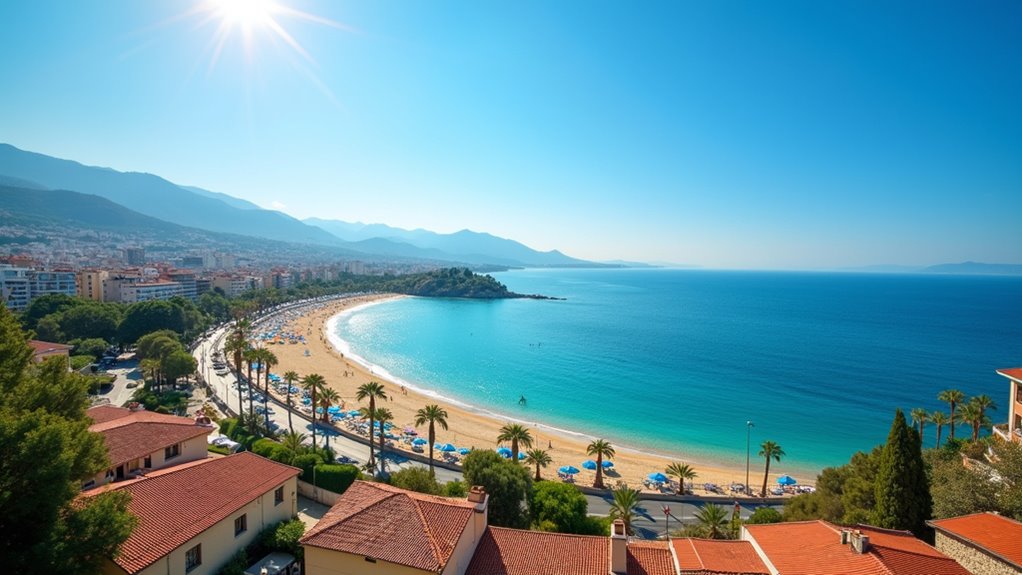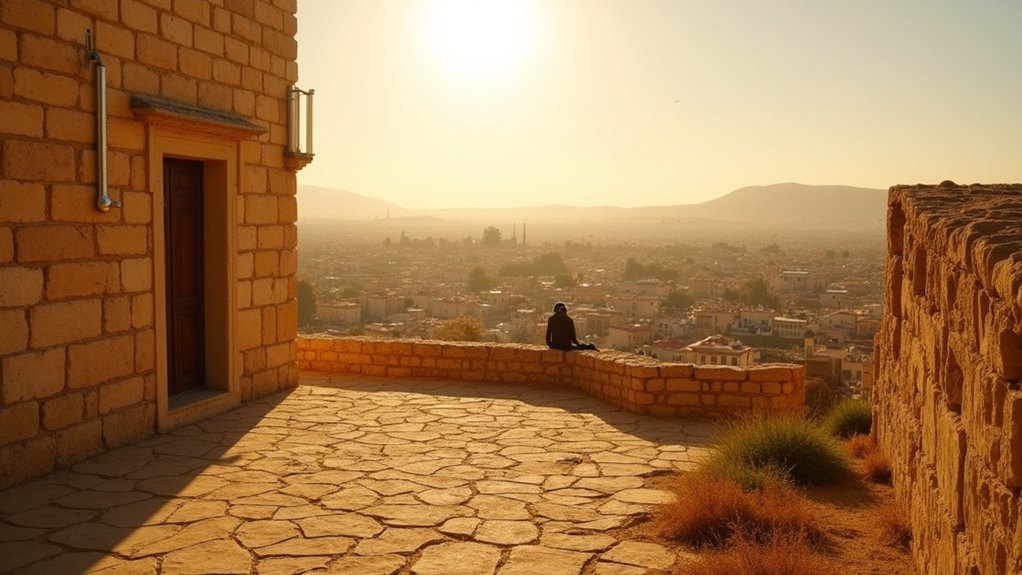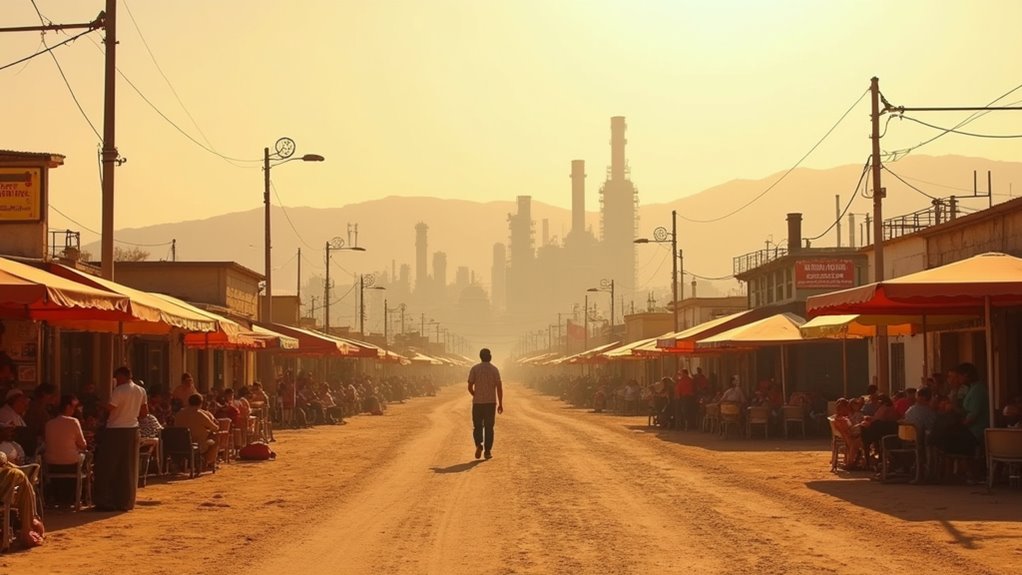Physical Address
304 North Cardinal St.
Dorchester Center, MA 02124
Physical Address
304 North Cardinal St.
Dorchester Center, MA 02124

One of Turkey's scorching cities reaches a blistering 47°C, but which destination tops the list of heat-seekers' paradises?
Turkey’s hottest cities reach scorching temperatures of 47°C (116.6°F), with Şanlıurfa topping the list. You’ll find Antalya, Adana, Mardin, Diyarbakır, Gaziantep, and Batman following close behind. Visit between October and April to avoid extreme heat, or explore early mornings if summer travel is unavoidable. Pack light clothing, stay hydrated, and seek indoor cultural experiences during peak afternoon hours. The ancient stone architecture and culinary treasures offer cool respite from the unforgiving sun.

While many travelers seek to escape the heat during summer vacations, Şanlıurfa boldly embraces it as one of Turkey’s hottest destinations. Located in southern Turkey, this ancient city regularly sees temperatures soaring to 40°C (104°F), with a record high of 47°C (116.6°F) in July 2000.
When summer heat sends travelers fleeing, Şanlıurfa beckons with its scorching embrace at a blistering 40°C.
If you’re a heat lover, visit during July when average temperatures hit 32.4°C (90.3°F). July is particularly notable as it’s typically the hottest month of the year with consistently high temperatures. Otherwise, consider spring when the climate is pleasantly warm but not scorching.
Winter offers mild temperatures around 6.8°C (44.2°F) – cold for locals but comfortable for visitors from colder regions.
The city’s arid climate means you’ll enjoy clear skies and minimal rainfall, perfect for exploring its affluent historical sites. Unlike coastal regions where you might enjoy snorkeling spots, Şanlıurfa’s inland location offers a completely different type of vacation experience. Pack light clothing, sun protection, and plan outdoor activities for mornings or evenings.
Known for its stunning Mediterranean coastline, Antalya boasts a perfect blend of scorching summer heat and mild winter temperatures that attract visitors year-round.
You’ll enjoy average summer temperatures between 30°C and 34°C, with occasional heatwaves pushing the mercury to 45°C. Don’t worry about rain ruining your beach days – summers stay delightfully dry.
If you’re seeking budget-friendly travel, consider visiting during winter when temperatures remain a comfortable 15°C during the day. The area experiences its coldest temperatures in January, with lows around 42°F (about 6°C) while maintaining pleasant daytime conditions.
The region’s 300 annual days of sunshine make Antalya perfect for outdoor enthusiasts. You can ski in the mountains and swim in the Mediterranean on the same day during certain seasons – a unique experience few destinations offer.
For the best value, plan activities around the abundant sunshine that powers this tourism hotspot. While enjoying Antalya’s warm climate, many travelers also take advantage of its vibrant nightlife scene that rivals popular party destinations in nearby Cyprus.

Moving southeast from Antalya’s coastal paradise, you’ll encounter Adana, Turkey’s scorching southern powerhouse. With temperatures soaring up to 94°F in summer and a record high of 46°C (115°F) in August 2023, you’ll need to prepare for serious heat when visiting this agricultural hub.
When exploring Adana’s sun-drenched landscape, remember these essentials:
When hiking around Adana’s countryside, be cautious as the warm climate attracts venomous snake species that thrive in the region’s hot conditions.
The city enjoys an impressive 11-month growing season that supports its flourishing agricultural economy, with favorable conditions for plant growth extending from early February to early January.
Perched dramatically on a rocky hillside in southeastern Turkey, Mardin combines scorching summer temperatures reaching 99°F with some of the country’s most breathtaking ancient architecture.
Mardin’s ancient treasures cling to rugged hillsides where summer heat meets timeless architectural splendor
The city’s yearly average of 67.7°F makes it one of Turkey’s affluent destinations.
You’ll find the ideal time to visit is during spring or fall when temperatures are more moderate. July stands out as the hottest month of the year, with average temperatures of 98°F high and comfortable evenings.
Mardin ranks among the top warm cities in Turkey, with temperatures that rival coastal destinations.
Don’t miss the stunning Kasımiye and Zinciriye Madrasahs, where ancient stonework has withstood centuries of extreme weather. These structures stay remarkably cool inside despite the heat outside.
For budget travelers, local guesthouses offer authentic experiences at reasonable prices.
The city’s tourism infrastructure continues to develop, with guided tours available to help you navigate Mardin’s affluent cultural tapestry spanning numerous civilizations and architectural wonders.

With temperatures soaring beyond 104°F in summer months, Diyarbakır’s continental climate creates stark seasonal contrasts that shape your visit to this ancient stronghold. This UNESCO-listed city offers remarkable experiences despite its extreme weather. While not as internationally renowned as luxury European destinations, Diyarbakır provides authentic culture at a fraction of the cost.
When visiting this basalt-built marvel, consider:
As temperatures soar to a blistering 111°F during peak summer months, Gaziantep’s renowned culinary scene offers both refuge and revelation for heat-weary travelers.
You’ll find respite in air-conditioned restaurants serving cooling yogurt-based dishes and mint-infused beverages that locals have perfected over generations. The city’s elevation (838m) provides minimal relief from summer highs averaging 97°F, though nights cool to a more manageable 72°F. Compared to other Mediterranean destinations, Gaziantep offers excellent value dining despite its world-class cuisine.
Visit between October and April to avoid the scorching heat when temperatures regularly exceed 104°F for three months straight. The clearest skies occur between May and October, making this period ideal for photography despite the heat. When exploring UNESCO-recognized food destinations, plan morning outings before retreating indoors during peak afternoon heat.
Gaziantep’s drought-resistant pistachio orchards and seasonal harvests reflect centuries of agricultural adaptation to this extreme continental climate where January temperatures can plummet to freezing.

While Gaziantep dazzles visitors with its culinary treasures, Batman sizzles under even more intense desert-like heat in Turkey’s southeastern region. This oil-rich city experiences scorching summers with July temperatures often exceeding 38°C (100°F) and occasionally reaching a blistering 42°C (107°F). The city features a warm and temperate climate classification according to the Köppen-Geiger system, despite its extreme summer conditions.
If you’re planning to explore Batman’s cultural heritage:
Winter travelers will enjoy mild temperatures between 1-10°C and can experience the authentic local culture without summer crowds. Those seeking Mediterranean alternatives might consider Cypriot resorts which offer similarly warm climates with coastal advantages.
As you’ve discovered Turkey’s hottest destinations, you’ll find ironically that these scorching cities offer the coolest cultural experiences. Don’t let the thermometer scare you—pack light clothing, stay hydrated, and explore early mornings or evenings when temperatures dip. Local tea gardens provide affordable respite from the heat while immersing you in authentic Turkish culture. The most blistering cities often warm hearts with their hospitality, not just their weather!